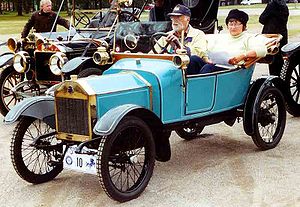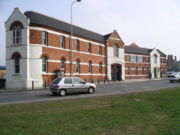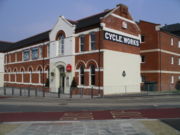
Swift Motor Company
Encyclopedia



Coventry
Coventry is a city and metropolitan borough in the county of West Midlands in England. Coventry is the 9th largest city in England and the 11th largest in the United Kingdom. It is also the second largest city in the English Midlands, after Birmingham, with a population of 300,848, although...
, England from 1900 until 1931.
Founded by James Starley as a sewing machine maker in 1859, the Coventry Sewing Machine Company as it was then called, started making bicycles in 1869 and changed its name to Coventry Machinists. In 1896 they became the Swift Cycle Company and started to make motor cycles in 1898. Swift made their first single-cylinder car in 1900 using an MMC engine. It had an unusual transmission system involving an unsprung two ratio rear axle. This proved unreliable and was replaced by a more conventional layout in 1903. In 1902 a separate company was formed for motor vehicle production and registered as the Swift Motor Company. Production had originally been in the Cheylesmore Works but car assembly moved to a new factory, Quinton Works in Mile Lane in 1906.
The first Swift-engined car was the twin-cylinder 7, later 10, horse power of 1904. This was shortly afterwards joined by the four cylinder 12/14 which continued in a bewildering number of guises until the First World War.
As well as the cars made by the Swift Motor Company, in 1904 a single-cylinder 700 cc cyclecar was produced by the Swift Cycle Company Ltd. This car carried a cloverleaf emblem on its radiator and this was adopted by all the cars.
In the years 1909–11 another single-cylinder 7 hp car was manufactured, this time with 1100 cc. This car was also sold by Austin
Austin Motor Company
The Austin Motor Company was a British manufacturer of automobiles. The company was founded in 1905 and merged in 1952 into the British Motor Corporation Ltd. The marque Austin was used until 1987...
as the first Austin 7
Austin 7
The Austin 7 was a car produced from 1922 through to 1939 in the United Kingdom by the Austin Motor Company. Nicknamed the "Baby Austin", it was one of the most popular cars ever produced for the British market, and sold well abroad...
.
A larger car, the 15, with a 3-litre engine was added to the range in 1913, and this continued to just post-war. During the First World War, car production ceased.
After the war ended, the Cycle Car company was merged with the main company as Swift of Coventry. The range was simplified with the excellent 1100 cc 10 continuing and joined by a 2-litre 12 with a 4-speed gearbox. A new 10 was launched in 1923 as the Q type with coil ignition, electric starting, optional front wheel brakes and a top speed of 55 mi/h. Standard front wheel brakes were added in 1926 and the engine was bored out to 1190 cc to become the P type. The engine grew again to 1307 cc in 1929 when the car became the P2.
Harper Bean, who also made Bean Cars
Bean cars
Bean Cars were made in factories in Dudley, Worcestershire, and Coseley, Staffordshire, England, between 1919 and 1929.-Origins:The company traced its origins beck to two auto-industry component suppliers, A Harper and Sons and Bean Ltd., both based in England's Black Country...
, bought 50% of Swift's ordinary shares in 1919, but got into severe financial difficulties later that year, seriously affecting the company's finances.
The 12 was replaced by the 12/35 in 1925 with front wheel brakes, plate clutch plus an increase of 24 inches (609.6 mm) in the wheelbase.
The final Swift car was the 1930 Cadet, which was an attempt to compete with the £100 cars. This had an 850 cc Coventry Climax
Coventry Climax
Coventry Climax was a British forklift truck, fire pump, and speciality engine manufacturer.-History:The company was started in 1903 as Lee Stroyer, but two years later, following the departure of Stroyer, it was relocated to Paynes Lane, Coventry, and renamed to Coventry-Simplex by H...
engine and a price of £149 for the tourer and £165 for the saloon but Swift was too small to compete with the likes of Ford and Morris, and closed in 1931 after its suppliers foreclosed on their debts. Coventry Climax were left with a number of engines from the Cadet model, which they used as the basis of their Second World War fire pump engine designated FSM, the SM standing for Swift Motors.
Principal Swift cars
| Year | Type | Engine | Production |
|---|---|---|---|
| 1904-8 | 7/8 | 905 cc side valve two cylinder | |
| 1904–1907 | 9/10 | 1399 cc side valve 2 cylinder | |
| 1904–1907 | 12/14 | 1348 cc side valve 3 cylinder | |
| 1909–1911 | 7 | 1100 cc side valve single cylinder | |
| 1905 | 9 | 1703 cc side valve 2 cylinder | |
| 1905–1907 | 16 | 2672 or 2799 cc side valve 4 cylinder | |
| 1908–1912 | 10/12 | 1560 or 1778 cc side valve 2 cylinder | |
| 1908–1912 | 15/18 | 3119, 2308 or 2724 cc side valve 4 cylinder | |
| 1908 | 25/30 | 4942 cc side valve 6 cylinder | |
| 1909 | 18/20 | 3556 cc side valve 4 cylinder | |
| 1912–1914 | 8 hp | 1362 or 1526 cc side valve 4 cylinder | |
| 1913–1914 | 15 and 16/20 | 3052 cc side valve 4 cylinder | |
| 1913–1914 | 10 | 1328 cc side valve 4 cylinder | |
| 1913–1924 | 12 (12/35 from 1925) | 1940 cc side valve 4 cylinder | approx 1500 |
| 1914–1915 | 11.9 | 1795 cc side valve 4 cylinder | |
| 1914–1915 | 15.9 | 2610 cc side valve 4 cylinder | |
| 1915–1922 | 10 ED | 1122 cc side valve 4 cylinder | approx 1500 |
| 1915–1930 | 15 | 2938 cc side valve 4 cylinder | |
| 1922–1927 | Ten (Q-Type, QA from 1925) | 1097 cc side valve 4 cylinder | approx 4500 |
| 1924 | 18/50 | 2951 cc side valve 4 cylinder | prototype only |
| 1925–1930 | 14/40 | 1954 cc side valve 4 cylinder | |
| 1926–1931 | P-Type (2P from 1928, 3P from 1929, 4P from 1930 and 5P in 1931) | 1190 cc side valve 4 cylinder | |
| 1930-31 | Cadet | 847 cc Coventry Climax side valve 4 cylinder | approx 250 |
Quinton Works

Cheylesmore
Cheylesmore is a suburb in the southern half of the city of Coventry, West Midlands, England. It is one of Coventry's largest suburbs, sharing borders with Whitley and Stivichall in the South, extending into Coventry city centre and bordering with Earlsdon in the North. Cheylesmore has two...
, Coventry, originally built in 1890 for S & B Gorton for cycle manufacture, was acquired in 1905 by the Swift Motor Company, who made a motor cycle and a motor tricycle in 1898, and a conventional car by 1901 in their Cheylesmore Works in Little Park Street, but needed more factory space.
The frontages of the Quinton Works have been preserved and the building is now used as a hotel.

